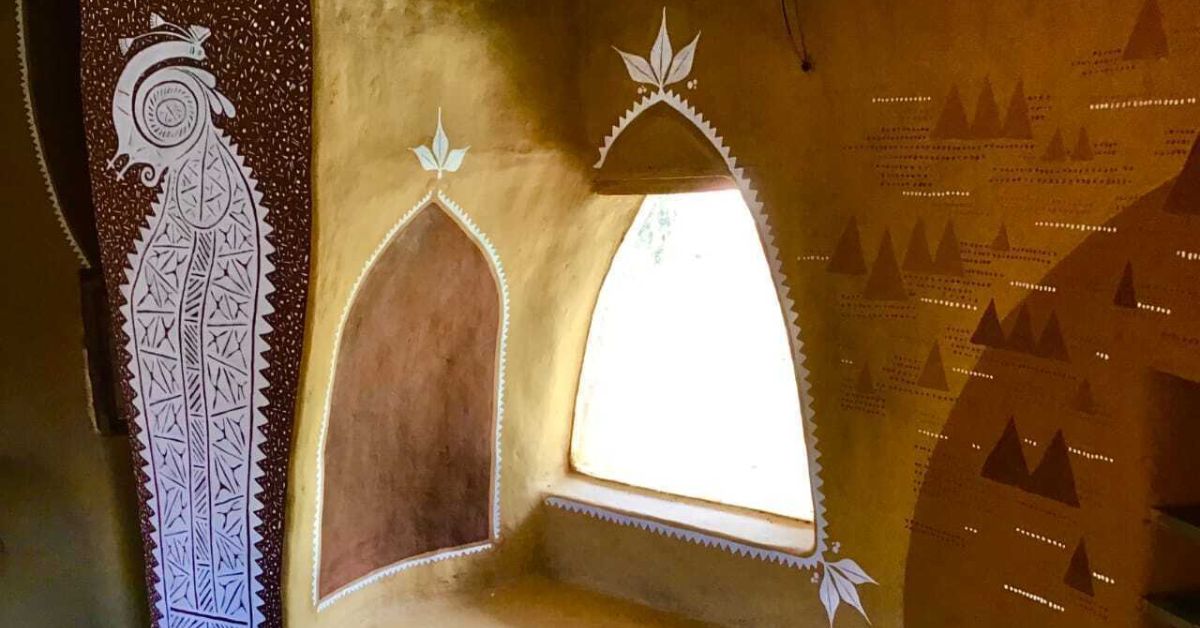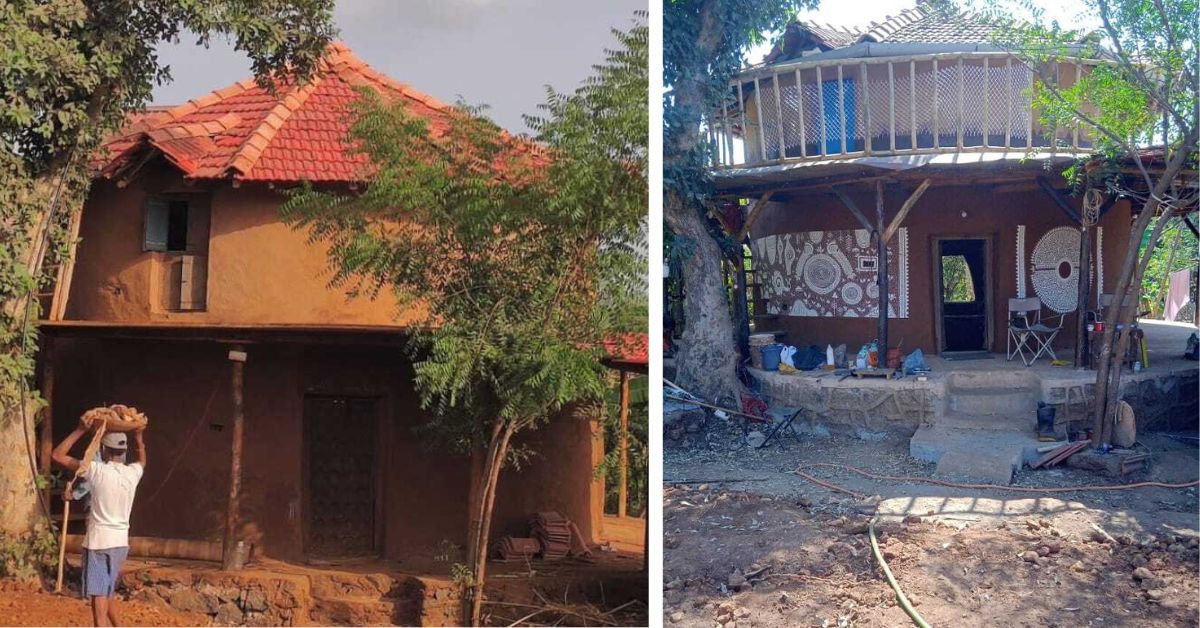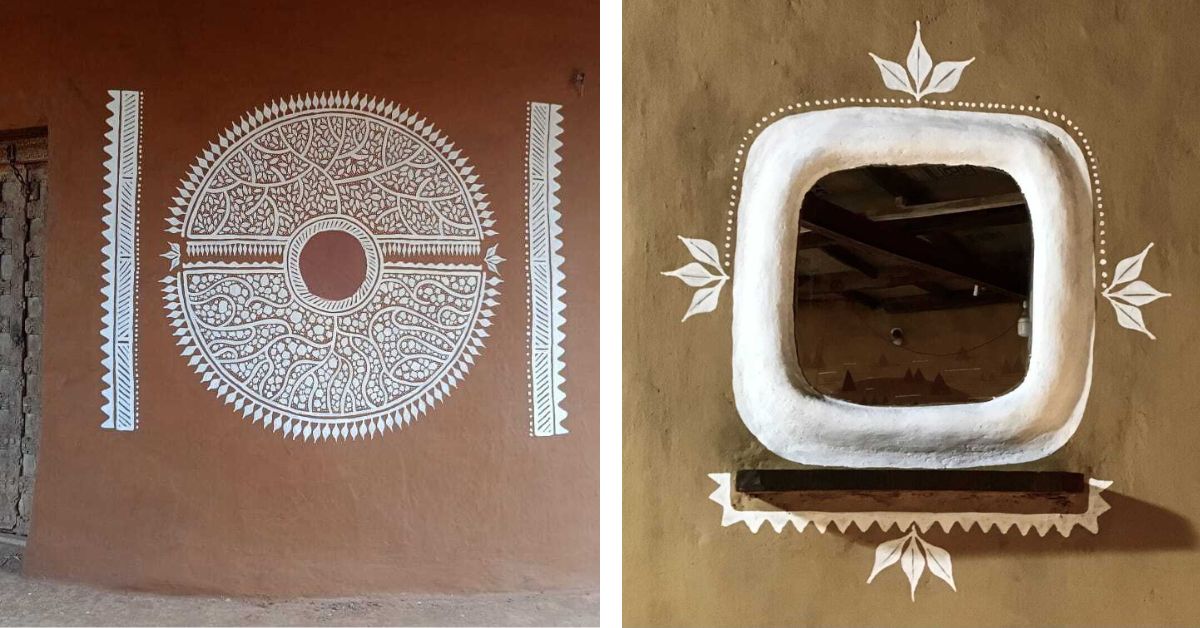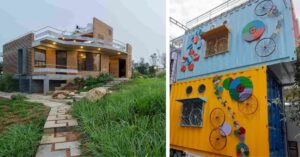Father-Son Duo Build Dreamy Sustainable Home Using Mud, Straw & Cow Dung
Collaborating with award-winning artist Lakhichand Jain and Geeli Mitti, Kiran Amati built a unique sustainable home near Mumbai using natural materials like wood, mud, cow dung, and straw.

When asked about our dream house, most of us would have a conventional answer: a house with minimalist interiors and modern architecture. However, Kiran Amati had an entirely different idea of a dream house.
Living in the high-rise apartments of Mumbai, Kiran yearned to lead a simple life. “The two things I have always been passionate about were sustainable living and music. Working a corporate job, I had always wanted to pursue my passions,” he says.
Kiran’s time finally came in 2020 when his daughter was born. He decided to become a stay-at-home dad and pursue his music career. Simultaneously, he resolved to build his dream home with his father on a half-acre farm, 60 km from the city.
The father-son duo chose an unconventional path, opting to construct their home using mud, straw, clay, local soil, stone, cow dung, and lime. A labour of love, the duo hand-built their home with the assistance of volunteers and the collaboration of Lakhichand Jain, a national award-winning visual artist, designer, and scholar.
In a conversation with The Better India, Kiran explained the motivation, inspiration, and the process involved in making a mud home.
A full-time musician, stay-at-home dad and nature enthusiast
Kiran’s father, Prakash, is also a nature enthusiast and has always dreamt of owning cattle on his farm.

“We used to ponder a lot on the kind of house we wanted that would accommodate both our wishes. While we were certain that our home would have space for my father to have at least two cows, we were unsure about the structure,” he says.
“It was only after he retired and I decided to be a stay-at-home dad that we started seeking answers,” he says.
With Kiran’s wife also on maternity leave, he managed to find time to visit villages and learn about their way of life.
“Meanwhile, my father discovered Dr Malik in Rajasthan, who conducts a four-day workshop where participants learn to make adobe bricks using cow dung, lime, and mud. Since we were keen on being as nature-friendly as possible, my father decided to take the course,” he says.
At the same workshop, Prakash met Shagun Singh, the founder of Geeli Mitti Centre of Excellence, a Uttarakhand-based organisation that makes mud houses.
“I looked them up and found some of the sustainable houses they had made and was convinced that this was what I wanted to do,” he says.
The duo decided to take a month-long course to understand what it takes to make a mud house.
“By the end of the course, I believe we had a clear idea of the size of the house we needed, how the rooms would be divided, and a basic structure design in mind,” he recalls. 
Shagun also provided architectural advice to the duo for building their dream house.
“We executed the whole plan ourselves and did not hire any contractors. Traditional contractors would have no idea how the materials utilised in our house’s construction are used,” he says.
“We just enlisted four labourers from the nearby village and started building. It all just came together. We also shared the project details on Facebook and WhatsApp, and anyone interested in learning and volunteering could join,” he says.
The duo had about 80 volunteers throughout the construction of the house. In 2022, they started their six-month-long journey of love and labour and named their home — Om Niwas.
Father-son’s labour of love
The circular home, with a diameter of 16 feet, is a studio-style space with bedrooms, a kitchen on the ground floor and a meditation space on the first floor.
“There are no partitions in the entire house. We have a sofa in the living room and a bed in the bedroom, all made of mud,” he informs, adding that the first floor is mostly empty space with art made by award-winning artist, Lakhichand Jain. The walls have beautiful Mandana art with tantra motifs.
The floors of the house are made of an interesting combination of wood and straw. “So there were a lot of felled trees in the village. We decided to chop the wood up and lay it on the floor. For the space that remains in between, we filled it with sawdust and Fevicol, a type of mortar, and then we just sanded it on top and put polish,” he explains. 
For the walls, the duo used mud. He says, “The foundation is entirely made of stones, constructed without any mortar, making it a dry stone foundation. The plinth consists of stones with lime, along with Suruki mortar. Suruki is similar to brick powder, serving as an aggregate for the mortar. The walls are constructed entirely from mud, providing a pure mud composition.”
In addition to being made with sustainable materials, the house also uses a unique method for its waste management.
“I think the septic tank is worth mentioning. It’s a dry septic tank, not the usual kind where all sewage and kitchen waste overflow. We created a mixture using dry leaves collected from falling trees, along with a bit of lime and sawdust. We mixed these three components outside and dumped the mix into the septic tank, filling at least 70% of the tank with this combination,” he explains.
Over the time of 4 to 5 years, the waste keeps getting decomposed before you have to refill the mix.
Talking about some hurdles he faced during the construction of the house, he says, “We couldn’t secure the right manpower, and those we did find were unfamiliar with the materials required. It became an experimental process, where we tested the proportions of sand, clay, and lime a few days before application. The results were unpredictable, and when failures occurred on the walls, we had to scrap the entire section and start over.”
“However, redoing and brainstorming with volunteers made the whole process really fun. It is not like the conventional homes where there will be one contractor who will come and oversee things while a machine mixes the mortar. We really got to get our hands dirty,” he says.
While in the initial stages, the house got many critical reviews, the house is today a landmark in the village. “They would say Mumbai rains heavily, and it’s hard to imagine a mud house sustaining for more than two or three years here. Despite the constant chatter from self-proclaimed experts in the village, offering their invaluable advice on how things should be done, we simply ignored it,” he says.
“Now it is known throughout the village. So whenever an auto driver needs directions to the village, locals guide them by referring to our mud house. Many people from the village have visited us, making it a recognisable landmark for the community,” he says.
(Edited by Padmashree Pande)
If you found our stories insightful, informative, or even just enjoyable, we invite you to consider making a voluntary payment to support the work we do at The Better India. Your contribution helps us continue producing quality content that educates, inspires, and drives positive change. Choose one of the payment options below for your contribution- By paying for the stories you value, you directly contribute to sustaining our efforts focused on making a difference in the world. Together, let’s ensure that impactful stories continue to be told and shared, enriching lives and communities alike. Thank you for your support. Here are some frequently asked questions you might find helpful to know why you are contributing?

This story made me
- 97
- 121
- 89
- 167













